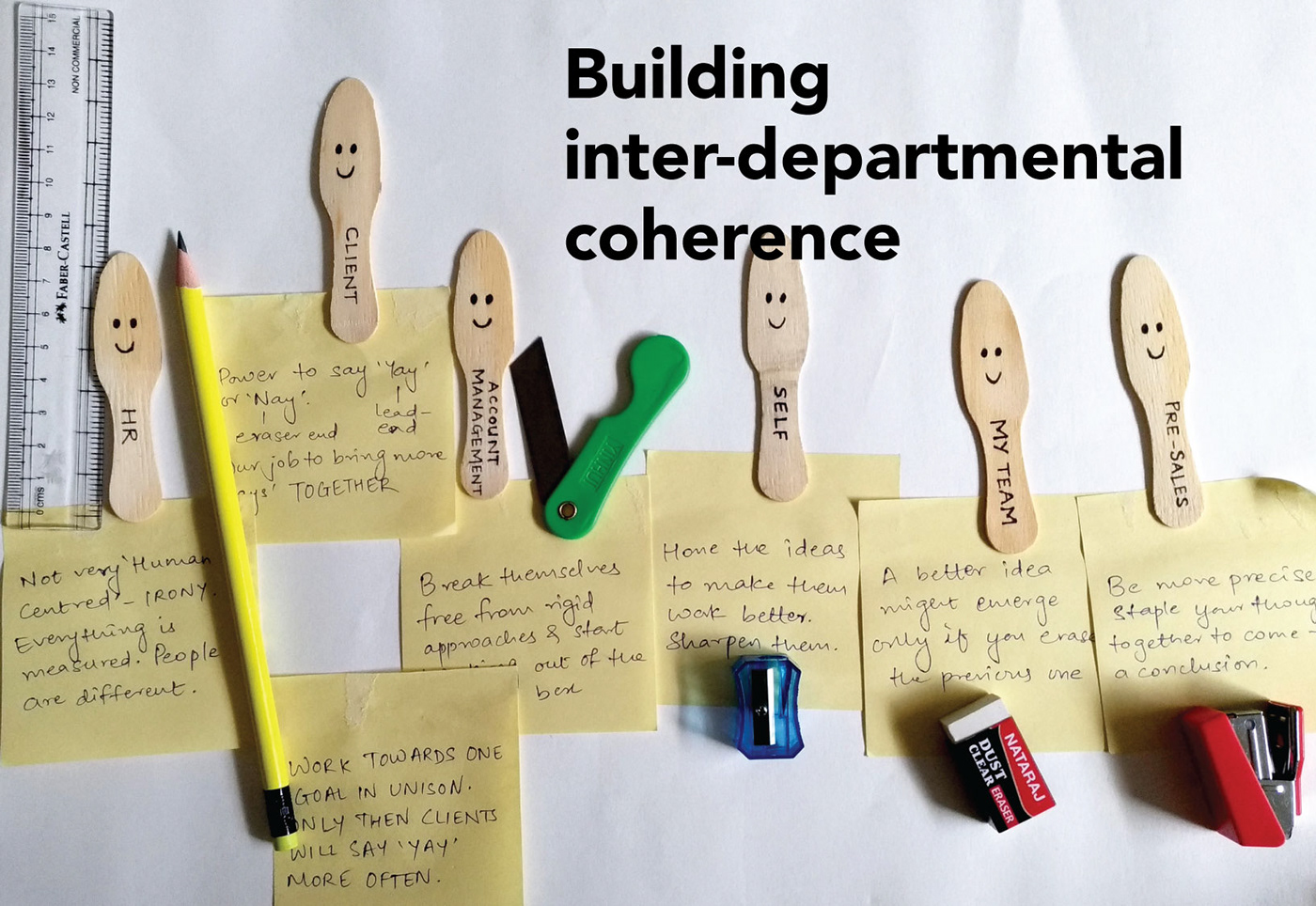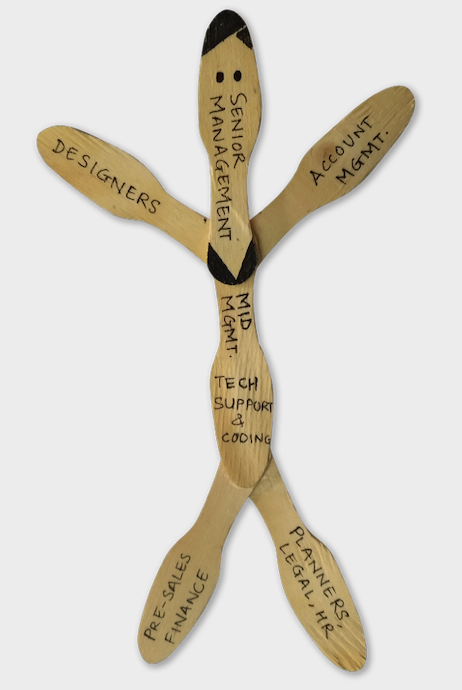
How can design leaders build inter-departmental coherence within communication design set ups?
Incoherence between people working together could be caused due to lack of proper communication, language barriers or the lack of drive to understand the other person empathetically. My experience of working especially in advertising, has taught me that incoherence is the root cause of misunderstanding between teams which affects agency-client relations, lowers employee happiness and has a negative impact on the work.
I ran a series of experiments to understand the actual cause of incoherence and how it could be overcome within communication design setups. I’ve made a short video to communicate my findings of these short experiments. I found that expressing yourself through an audio-visual medium brings more clarity to your thoughts and teaches you to go slow while doing so! Scroll down for the videos.
Introduction
The Gestalt theory that emphasizes that the whole of anything is greater than its parts, has encouraged me to view the complex environment of communication design set ups like advertising agencies, branding firms, interaction design studios as the ‘whole’ and their several departments like design, coding, account management, human resources, finance as ‘parts’ forming this whole. Internally, these parts need to work with one other to deliver the best possible design solutions so that they can externally interact with clients, vendors, investors and users, smoothly. However, it is often observed that the people working in different departments (parts) work in silos and therefore feel separated, isolated and alone. Brent Gleeson, Founder and CEO at TakingPoint™ Leadership, states that departmental silos are seen as a growing pain for most organizations of all sizes. It leads to mistrust and an even stronger disconnect between people, functions, business units and ultimately their relationship with clients and customers suffers. More often than not silos are the result of a conflicted leadership team.
Design leaders also have to deal with the complexities of their businesses like organizational structure, processes, infrastructure, tools, facilities, products, services and interfaces. They need to be cognizant of the fact that these functions are run by people with varying skill sets and expertise. This large mesh of people, departments and procedures could lead to confusion and people working in dissonance. A siloed structure is not only restricted to departments or skill sets but also extends to geographies, cultural beliefs, languages. Sometimes, the people who must work together are unable to communicate with one another because they are culturally misaligned, or inherently mistrustful and territorial. These problems can complicate inter-personal and professional relationships within the organization.
Therefore, it is crucial to investigate:
How do design leaders in communication design set ups build coherence within the organization to create congruous workplaces for employees and ultimately win the clients’ trust?
Methodology
I have used desktop research and studied journal articles in order to set the context for the current working environment in design agencies. This method has been specifically implemented to understand the following sub-questions:
1. Whether silos exist within these set ups and if there is need to break them down
2. How internal coherence could have a positive impact on employees and hence clients
3. What the leading design agencies are doing in this matter
4. How design leaders, globally, are driving this transformation through innovative methods and ideologies
Equipped with the data of the current scenario, I have designed and conducted one-on-one co-design workshops and a dyad interview with design leaders from advertising agencies and branding studios. A dyad is a meditative practice in which one person asks one question repeatedly for some time and only listens without judgement, while the other person gives different answers every single time. The intent behind using these methods was two-fold:
1. To understand their relationships with people working in different departments through cultural probes
2. Finding practical solutions to the lack of coherence through a dyad
Since I was looking for inputs on design leadership from people in senior management roles, I used a simple customized toolkit as a way to start a conversation and dig deeper into their relationships with other departments, encouraging discussion about novel possibilities and stimulating the imagination of the respondent. It was designed to be “delightful, but not childish or condescending” to encourage a playful, casual attitude from participants (Gaver et al, 1999, p. 25).
Password: coherence
Figure 1:
A stick figure made of popsicle sticks representing the different departments was used to start a conversation around coherence. It was necessary to set the premise right since coherence could mean different to different people.

Figure 2:
The toolkit consisted of stationery articles like pencil, sharpener, eraser, stapler, ruler and paper cutter. Popsicle sticks were used to represent the people like self, their team (designers), pre-sales, account management, tech support, human resources and the client.

Figure 3:
The participants were asked to assign each object to one department and the reason behind doing so. They arranged the objects as per their interpretation of their relationships – either in close proximity or far away. Sticky notes were used to briefly describe their thoughts and analogies.

Figure 4:
I conducted and recorded a dyad interview in which I asked them: “Tell me a way you can build coherence within your organisation.” They were asked to give precise answers to the same question repeatedly for ten minutes.

Password: dyad
Documentation of the data was done through article excerpts, written notes, recorded interviews and observation of the participants primarily through listening via all five senses. The data was then analyzed to gather project-related as well as personal insights.
Research
An article published by PWC, ‘Dealing with market disruption’, states that silos can exist to harness knowledge-based skills and are sometimes even vital to productivity. However, it is argued that an extreme case of valuing domain expertise, divided ownership of processes and geographical locations could lead to problems that arise when disparate parts of the company fail to work together with a shared sense of mission. Hence, to stay competitive in the face of increasingly accelerated disruption, many companies need to rethink and retool their offerings and operations.
In his book, The Division of Labour, the French sociologist, Emile Durkheim, proposed the theory of ‘collective consciousness’. He expressed that it is the set of shared beliefs, ideas and moral attitudes which operates as a unifying force within society. Similar to the Gestalt principle, he claims that a society is created when individual consciences interact and fuse together to create a synthetic reality that is completely new and greater than the sum of its parts. I have explored the assumption that a design organization that works towards a common goal by supporting each other could deliver better outcomes than the sum of its parts.
The popsicle figure 1 was shown to the participants to represent the idea that their design setup stands as a whole unit and cannot function without all the parts working in cohesion. Although, this triggered conversations around why a particular part was named at that location in the figure, the tangibility helped me delve into the topic of coherence instantly. The use of cultural probes done by assigning stationery objects to people/departments revealed what they expected out of each of them and how a diverse representation at a decision-making level could help build stronger organizational bonds and reduce confusion. It was agreed that this could further lead to an increase in the employee happiness quotient resulting in building trust within the client community.
Design leaders rarely get the chance to think peacefully and take a pause to come up with ideas. They say, “Everything is wanted yesterday.” The dyad conversation gave them the chance to ponder on the same topic with focus and without judgement. This exercise unveiled some solutions that were unexpected from senior leaders. One such example shared by Ipsita Ghosh, Senior Creative Director, McCann Worldgroup, Mumbai, was, “What if for a day an intern dons the hat of a creative director, the copywriter becomes the account management executive and the art person writes copy?” This insightful statement opened a lot of possibilities around the different acts of leadership need to be consciously brought in. Such small and practical exercises could help people gain a deeper consideration of one another’s constrains as well as reflect on their own practice through someone else’s perspective. That’s the closest we could go to an actual lived experience.
As mentioned by Louise Long in one of her interviews, it is important for one to know what you know and don’t know. This humility would bring in curiosity about what others are doing and how, inculcating a sense of empathy towards problems faced by partner departments finally leading to building on diversity rather than focusing on differences.
Colin Forbes, Partner, Pentagram, in his article on the firm’s 20th anniversary has reflected upon how ideologically they enabled the five partners to work both independently and in collaboration, which is how Pentagram works to this very day. This has led me to a paradoxical idea of an act of leadership that creates a sense of constrained freedom which builds a sense of responsibility but also creates conducive environments for people to become the best versions of themselves. A successful design leader would be the one who can strike the right balance between authority and compassion.
The global design and innovation company, IDEO, emphatically states on its website, “We are a community of designers, entrepreneurs, engineers, teachers, researchers, and more. Our shared values and beliefs influence the work that we do, and the impact we hope to achieve.” The manifestation of this mind-set is ‘The Little Book of IDEO’. It emphasizes that one can check off a list of technical skills and expertise that one brings to the table or a career development rubric to make sure one is hitting the right goals. But often, it’s the behaviours- the intangibles that are the most difficult to articulate - that make the most impact. A scan of this beautifully designed book revealed that impactful leadership helps one stay optimistic and embrace ambiguity through one’s willingness to adapt when there’s no roadmap if all are headed in the same direction.
The book itself is a great example of embodying human centeredness within leadership - free from corporate jargon, focused on delivering high utility, giving priority to the how versus the what of design doing in case people hit road blocks.
Conclusion
Project related, professional as well as personal insights surfaced through the research. My initial assumption that silos need to be broken down for bringing in coherence had to be altered. Through research, I realised that in certain situations, confidentiality is crucial whereas in some others, it may create mistrust, thus creating hindrances in smooth functioning. Since every work environment demands something more than the sum of the parts like good communication, transparency, mutual respect, it needs the bigger ‘whole’ of coherence which encompasses the motivation to work towards what’s best for the success of the organization and the people working in it.
Project related, professional as well as personal insights surfaced through the research. My initial assumption that silos need to be broken down for bringing in coherence had to be altered. Through research, I realised that in certain situations, confidentiality is crucial whereas in some others, it may create mistrust, thus creating hindrances in smooth functioning. Since every work environment demands something more than the sum of the parts like good communication, transparency, mutual respect, it needs the bigger ‘whole’ of coherence which encompasses the motivation to work towards what’s best for the success of the organization and the people working in it.
